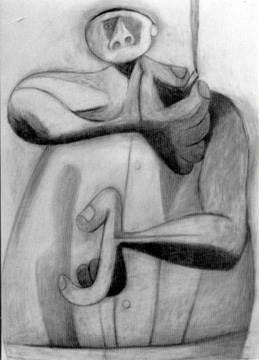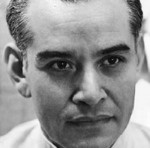
Rufino Tamayo
Mexican, 1899-1991
The Smoker, 1947
crayon on paper
29 x 21 1/2 in.
SBMA, Gift of Mr. and Mrs. William H. Wilson
1991.44

Undated photo of Tamayo
COMMENTS
Rufino Tamayo’s first direct links to the international avant-garde were established during his visits and extended stays in the United States. Of particular significance to him was his viewing of Picasso’s 1940 exhibition at New York’s Museum of Modern Art, which inspired an extended series of human and animal figures. From this period Tamayo’s El Fumador represents the artist’s interpretation of Surrealist metamorphosis in its combination of pre-Columbian simplicity and volume with Picassoesque Cubo-Surrealist distortion.
An icon of modern Mexican art, Tamayo was called the "The Fourth Great One" and was inducted into Mexico’s "national pantheon" alongside Los Tres Grandes (The Three Great Ones) of Mexican Muralism, José Clemente Orozco, Diego Rivera, and David Alfaro Siqueiros. Far and wide, his extraordinary paintings conjure familiar images of Mexico, its colors, textures, and centuries of indigenous and hybrid culture, perhaps most picturesquely, and stereotypically, epitomized by the country’s traditional marketplaces brimming with exotic flowers, tropical fruit, and native folk art. The lushness and materiality of Tamayo’s signature canvases readily encourage such an imagining and, as a result, have indelibly marked the artist as a formalist, a painter primarily interested in pure line, form, and color. While he has been contextualized among them, he has been most often considered a discordant counterpoint to Los Tres Grandes, whose ambition was Social Realism, in which aesthetics was wrought by politics. The persistent view of Tamayo as an ardent advocate of formalism, or arte puro (pure art), has impeded a fuller appreciation of the artist as well as his painting.
- Tamayo’s Re-envisionings
SBMA CURATORIAL LABELS
During the 1930s and 1940s, Tamayo often drew people smoking, an activity that was then thoroughly contemporary and a sign of modern sophistication. Cigarette companies made smoking appealing through advertising, and along with going to the movies, motorcars, comic books, magazines, and records, it was yet another cheap consumer item for people to buy with their increasing disposable income. Unlike Diego Rivera, also in this exhibition, or the other great Mexican muralists, Siqueiros and Orozco, Tamayo did not always align his work with explicit leftist and Marxist political positions.
Tamayo was born in Oaxaca to an indigenous family of Zapotec heritage, but moved to Mexico City as a child. In 1917, he enrolled at the Instituto Nacional de Bellas Artes (National Institute of Fine Arts) where he quickly became a star student, encouraged by Diego Rivera. By 1947, the year of this drawing, he had been splitting his time between New York City and Mexico City for about fifteen years. He had significant oneperson shows at Julien Levy Gallery, Weyhe Gallery, and Valentine Gallery, and museum shows in Chicago and Cincinnati. He also received significant state commissions for murals in Mexico, and in 1948 he had a solo show at Mexico’s Palacio de Bellas Artes.
- Serenity and Revolution, 2024
Born to parents of Zapotec descent in Oaxaca de Juárez, Oaxaca, Rufino Tamayo became a model for many younger figurative and abstract artists of La ruptura generation of the 1950s and ’60s. He was known for his break from the “Mexican School” of muralism and his openness to a range of influences and styles, which he amalgamated in his own personal style of abstract figuration. Tamayo became involved with the international avant-garde through visits and extended stays in the United States. Of particular significance to him was a 1939 Pablo Picasso exhibition at the Museum of Modern Art in New York, which inspired a series of human and animal figures. From this period, El fumador represents his interpretation of Cubism’s exaggerated forms, dramatizing gestures through extreme foreshortening.
- SBMA title card, 2013
Rufino del Carmen Arellanes Tamayo was born on August 25, 1899, in Oaxaca, Mexico. After the death of his mother from tuberculosis in 1911, Tamayo moved with his maternal aunt to Mexico City. Tamayo’s initial exposure to art began at age eleven, when he started collecting and copying postcards that reproduced famous paintings. After he completed primary school, Tamayo’s aunt enrolled him in accounting school, intending that he take over the financial records of the family’s fruit-vending business; however, Tamayo soon played hooky, sitting in instead on art classes at the Escuela Nacional de Bellas Artes (National School of Fine Arts) prior to enrolling formally in 1917.
During his first years as a practicing artist, Tamayo cultivated his visual language by engaging with some of the many art movements that emerged in Europe in the late nineteenth and early twentieth centuries, marking the heady rise of modern art. He worked with Impressionism, Neo-Impressionism, the Nabis, Fauvism, Cubism, and Futurism, for example, re-envisioning these artistic directions from a Mexican perspective. In the years immediate following Mexico’s successful Revolution of 1910-1920, Tamayo also explored national character, drawing upon nativist subject matter as well as social and political themes, even though his work has been largely defined as strictly formal.
Tamayo’s approach raised suspicions among Los Tres Grandes and their allies who doubted his commitment to an art capable of social and political change. Some even defamed him as a traitor to the cause of the Revolution, contributing to Tamayo’s decision to leave Mexico for New York, where he felt he could more easily find artistic freedom and success.
- SBMA Wall Text, 2000
